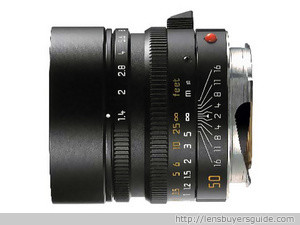Lens finder
Leica SUMMILUX-M 50mm f/1.4 ASPH
Full frame sized imageLenses that create APS-C sized image are designed for digital only. They cannot be used on cameras that have image sensor larger than the APS-C format. These lenses are not suitable for film cameras either. No stepping motor AFLenses with stepping motor focusing mechanism are better for contrast based focusing, and are quiter and faster than traditionally focusing lenses. Not stabilizedImage stabilization helps to reduce blur caused by hand shake, especially at high focal length or in low light situations. Image stabilization can give 1 to 3 stop advantage over none stabilized lens, based on the reciprocal rule. Metal mountCheaper lenses are usually equipped with plastic mount, while more expensive, professional lenses have metal mount. In general, metal mounts are more durable, and a good thing to have when lenses are changed a lot. When a camera is used mainly with one lens, the material of the lens mount is not that important. The front lens is fixedThe fixed front lens is not rotating during zoom and/or focusing. This allows the photographer to use petal shaped lens hood. Fixed front lenses also make the use of polarization filters a lot easier. No drop-in filter supportDrop-in filters are used in those lenses where either the front lens is too large, or the field of view doesn't permit the use of traditional filters at the front of the lens. Usually bright tele and ultra-wide angle lenses support this filter type. |
|
|
A combination of the know-how of Leica's engineers and the latest developments in manufacturing technology has resulted in this outstanding standard lens. It delivers high-contrast images, with high-resolution detail, even at its widest aperture, and down to its minimum focusing distance. This is made possible by a number of factors including the use of a floating element, special glass types with unique refraction properties, and elements with aspherical surfaces. The properties of this lens not only make it ideal for any photo situation demanding a handy all-rounder with the natural image angle of the 50 mm standard focal length, but also for available light situations, selective-focus shots, and even fine art photography - usually the preserve of much larger formats. Its wide-ranging versatility also makes it a top choice in assembling a Leica M lens outfit.
|
Leica SUMMILUX-M 50mm f/1.4 ASPH Specification
| Available mount(s) | Leica M |
| Application(s) | Portrait, Landscape, Architecture |
| Category(s) | Standard prime |
| Multiplier | 1× |
| Stabilizer | no |
| Focal length | 50 mm (prime) |
| Lens construction | 8 elements in 5 groups |
| Angle of view |
35mm: 47° digital: N/A |
| Number of blades | N/A |
| Maximum aperture | f/1.4 |
| Minimum aperture | f/16 |
| Minimum focusing distance | 45 cm |
| Magnification | N/A |
| Filter size | 46 mm |
| Size | ∅ 53.5 × 52.5 mm |
| Weight | 335 g |
| Notes |
|
| AF speed | N/A |
| AF sound | |
| Internal focusing | N/A |
| Internal zoom | N/A |
| Fix front lens | yes |
| Mount type | metal |
| Weather sealed | N/A |
| Drop in filter | no |
| Ultrasonic AF | N/A |
| Stepping motor AF | no |
| APS-C sized circle | no |
| Low dispersion lens element | N/A |
| Hard case | N/A |
| Soft case | N/A |
| Lens hood | N/A |
| Tripod adapter | N/A |
Leica SUMMILUX-M 50mm f/1.4 ASPH Reviews
Other reviews
Leica SUMMILUX-M 50mm f/1.4 ASPH in the news
- Tamron SP AF60mm f/2.0 Di-II Macro
- Nikkor AF-S DX 85mm f/3.5G ED Micro
- Carl Zeiss Distagon T* 35mm f/2.0 ZF
- Sony SAL2875 28-75mm f/2.8 SAM
- Carl Zeiss Distagon T* 28mm f/2 with EF mount
- Tamron SP AF17-50mm f/2.8 XR Di II VC LD Aspherical
- Carl Zeiss Distagon T* 2,8/21 for EF mount
- Carl Zeiss Distagon T* 3,5/18 ZE
- SIGMA 70-300mm F4-5.6 DG OS
- Nikkor AF-S 16-35mm f/4 G ED VR

